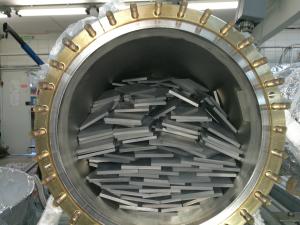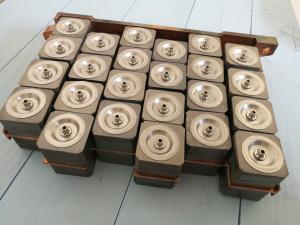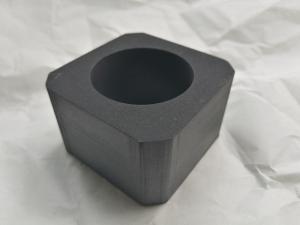B4C ceramic bricks prove their worth
A number of materials can effectively shield diagnostic equipment from the neutron flux coming from the plasma. To find the best one, the diagnostics team at ITER had to match efficacy with a number of other requirements, including overall weight.
The 25 diagnostic-hosting port plugs in the ITER tokamak serve two main purposes. One is to protect diagnostic equipment from neutron flux—either by either completely blocking the flux or by reducing it several orders of magnitude. The other is to provide the diagnostic equipment with a view into the plasma through windows and holes.
On the plasma-facing ends of the equatorial port plugs are three diagnostic shield modules—drawer-like structures that consist of a stainless steel frame and a diagnostic first wall. Behind the stainless steel frame, shielding material will be the last line of defense, reducing or blocking the neutron flux to protect sensors and auxiliary equipment.
Choosing material with the right properties
Choosing the right material to use for shielding was a process that required a number of steps, and input from several organizations. Not only would the material have to provide the right amount of protection, but it also had to respect a number of constraints.
One constraint is that each fully equipped port can weigh no more than 48 tonnes, which limits the kinds of shielding that can be used. "You can create a solid shield alternating layers of stainless steel and water," says Maxim Ivantsivskiy, Project Associate in the Diagnostic Engineering Section. "This would meet our requirements for reducing the neutron flux, but unfortunately this solution would be absolutely outside of the weight limit."
To find a solution that would remain within the weight limit, the ITER Organization and the US and Russian Domestic Agencies conducted independent studies. All three organizations came to the conclusion that boron carbide (B4C) would be the best material to use.
B4C is a very strong material, used for example in bulletproof vests and as armor for some modern tanks. B4C also has another advantage: whereas stainless steel and water slow down the neutron flux, B4C blocks the neutrons—providing even better protection. What's more, B4C is almost four times lighter than stainless steel.
Choosing the right form of the material
"Once it became clear that B4C was the right material, we had to figure out in what form," says Ivantsivskiy. "B4C can take the form of dust or sand, with which you can fill a box to provide shielding, or it can take one of several ceramic forms. We discussed different solutions with the working group and agreed that the best solution would be B4C in ceramic bricks, which would be much easier to manipulate."
The next step was to find out how to distribute the ceramic bricks to achieve the optimal tradeoff between shielding and weight. The team started by designing the shielding tray, which contains the B4C bricks. "We opted for a modular design, where you can alter the dimensions of the trays according to the shape of the diagnostic equipment," says Ivantsivskiy.
The idea is to house the optical sensors and mirrors inside the diagnostic shielding module, which is surrounded with shielding trays. One advantage of this approach is that if equipment is damaged, it is easy to remove only a small number of the shielding trays to reach it.
However if the space is completely filled with bricks, the weight limit is exceeded. "We found a solution that is quite elegant," says Ivantsivskiy. "We make a big hole in the center of each brick, which has the added advantages of creating a fixation on one side that can be used to attach the other structures. By making this hole bigger or smaller, we can manage the average density."
Another challenge that had to be overcome was the outgassing rate. "During the early stages of the project, the designers calculating the outgassing rates for pumps budgeted for each part of the tokamak," says Ivantsivskiy. "The budget included outgassing from port plugs too. But the ceramic bricks add to the surface area, and they weren't considered in the original exercise. A port plug can have up to 40,000 bricks, with a total surface area of 407 m², which is a lot of extra surface to take into account."
To determine if the port plug would remain within the outgassing budget, the missing piece of the calculation was the outgassing rate of each brick of B4C ceramic. The Russian Domestic Agency set out to find out what that was.
"We took 638 pieces of ceramics and cleaned them—first with ultrasound, then in water for 20 minutes—and then dried them at 120 degrees Celsius," says Ivantsivskiy. "The pieces were then baked for 4 hours in an oven at 1000 degrees. We put these bricks into a vacuum vessel and tested them according to ITER requirements."
"After just 5 hours of testing we demonstrated that we fall within the requirements. After 24 hours, it was even better. To take it a step further, we pumped and measured for one whole year. The outgassing rate decreased by a factor of 3.5."
After months of research, design tradeoffs and experimentation, B4C ceramic bricks have been shown to protect diagnostic equipment, and also meet the constraints of operating within diagnostic-hosting port plugs.




